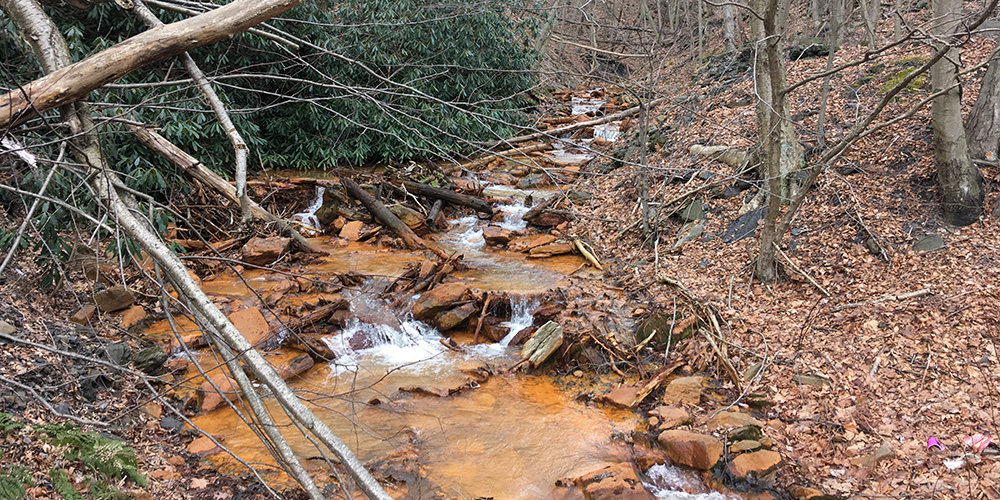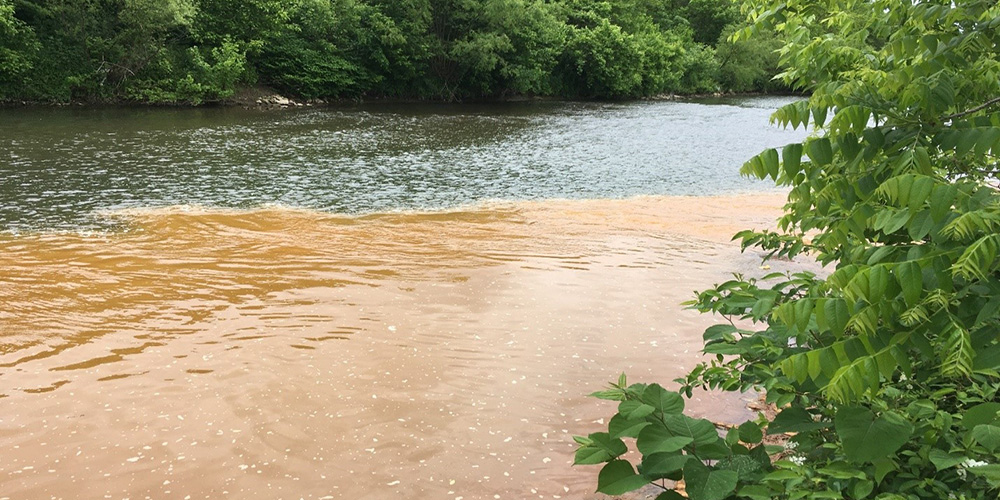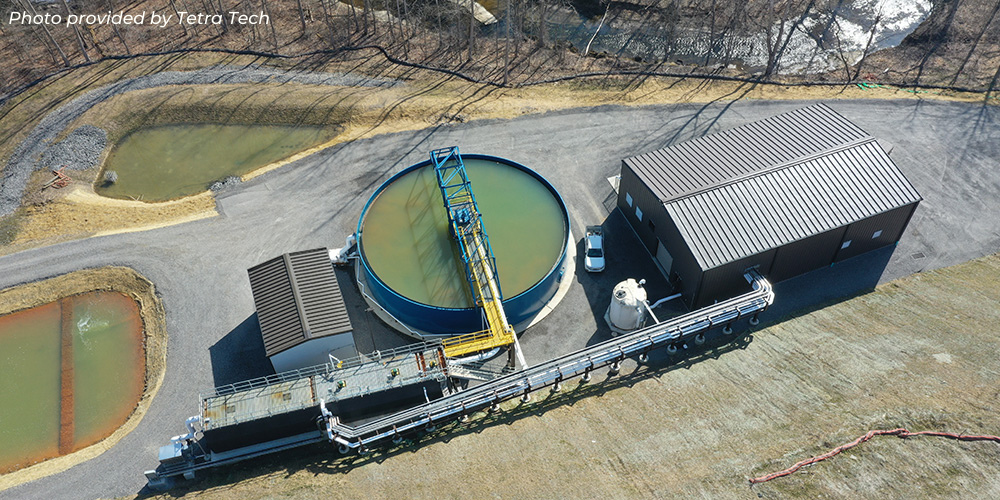Acid mine drainage (AMD) is the number one water pollution problem in Pennsylvania. Learn what the Pennsylvania Department of Environmental Protection (DEP) and other stakeholders are doing to restore watersheds impacted by more than 250 years of mining in the state.

“These are streams that you wouldn’t want to walk through.” – John Stefanko, Deputy Secretary, DEP Office of Active and Abandoned Mine Operations
What Is Acid Mine Drainage and Why Is It a Problem in Pennsylvania?
According to the
Eastern Pennsylvania Coalition for Abandoned Mine Reclamation, “Acid mine drainage is at its most basic level, water that flows through abandoned coal mines, interacts with the rock inside of mines, and flows from abandoned features (seeps, boreholes, tunnels).” Coal has been mined in Pennsylvania since the 1700’s providing many benefits to the state and its citizens in the form of energy and jobs, but there have also been negative impacts from coal mining, including AMD. Today there are over 5,500 miles of streams in the state with impaired water quality due to runoff from abandoned mines. Once pyrite (a naturally occurring mineral found alongside coal) is exposed to oxygen and water, the process of acid generation cannot be easily stopped. The acid runoff can continue for thousands of years until the pyritic material in the mine is deteriorated. It has been reported that there are mines from the Roman era that are still producing acid mine drainage nearly two thousand years after completion of the mine.
AMD is both an ecological and economic concern for Pennsylvania. AMD has rendered thousands of miles of streams and creeks biologically dead, no longer able to support most aquatic life. AMD can either be net acidic or net alkaline. Acid mine discharges typically limit any chances of a receiving stream to support any ecological life. Alkaline mine discharges can support some limited aquatic life; however, metals found in the water typically coat the stream beds limiting any chance of macroinvertebrates surviving.
Prior to the 1977 Surface Mining Control and Reclamation Act (SMCRA), mine operators were not required to mitigate the negative effects of their operations. Since the passing of SMCRA, mine operators are fully responsible to reclaim their mining operations, including the treatment of any water impairment. Currently, abandoned mines and any mine drainage associated with them have no responsible parties. Therefore, federal and state funds are relied upon to build and operate treatment facilities for the remediation of abandoned mines and AMD treatment. The most recent active mine drainage treatment facility, the Blacklick Treatment Facility, will cost just over $26 million dollars to construct and many more millions to operate and maintain throughout its expected life span.
In addition to the high cost to build and operate treatment facilities, the economic impacts of AMD can be seen in decreased tourism and outdoor recreational activities such as fishing, in AMD impacted areas. The Pennsylvania Fish and Boat Commission estimates an annual loss of $29 million in angler-generated revenue alone.

Millers Run stream discharge into Chartiers Creek in April 2020
The sulfuric acid in AMD can also cause damage to bridges, dams, wells, and docks. And last but not least, AMD impaired streams and rivers are a blight on the surrounding community.
AMD Treatment Facilities
The basic concept of an AMD treatment system is to raise the pH level of impacted waters and remove metals. The pH scale measures how acidic or basic a substance is on a 0-14 scale. The average pH level of fresh water is around 7 (which is neutral, neither acidic nor basic) while streams affected by acid mine drainage can have a pH as acidic as 2. To put this into perspective, this means that acid mine drainage water is 100,000 times more acidic than neutral water.

View of the Gladden AMD Treatment Plant in Allegheny County
To mitigate the effects of AMD in Pennsylvania, treatment facilities were constructed in the anthracite and bituminous mining regions of the state. At this time, DEP’s Bureau of Abandoned Mine Reclamation (BAMR) operates eight active facilities and 50 passive systems, while various non-governmental organizations such as watershed groups and conservation districts operate roughly 350 passive sites in the state. Systems that require equipment, round the clock maintenance and the addition of chemicals to the water are typically referred to as active treatment systems. Passive systems are typically built to handle smaller discharges and in addition to the use of chemicals, passive systems often add a biological component to the treatment, accomplished by routing water into a constructed wetland designed to buffer and precipitate the metals found in the mine water.
While the process of chemical treatment varies, a chemical oxidizer such as hydrogen peroxide is used to oxidize and precipitate dissolved iron and other metals from the mine water. The choice of active vs. passive treatment typically comes down to balancing the chemical reaction needed with available chemicals and cost. Passive treatment systems often cost more initially to install compared to active treatment, but they are designed to passively treat the water for 10 to 15 years, with minimal maintenance before replacement.
Challenges Facing AMD Treatment Facilities
There are many challenges involved with creating and operating an AMD facility. One such challenge comes with taking a project from inception to production. Identifying a solution and then implementing it can be a several years-long process. Another is the fact that most work is done on private land where uncooperative landowners can present a major hurdle.
But perhaps the biggest challenge faced with creating and operating an AMD facility is funding. Pennsylvania needs the most funding in the country for construction as well as operation and maintenance of the facilities due to the number of impaired waters here. The Hollywood treatment facility that was built in 2013 at a cost of $14.6 million dollars would today cost $20 million to build. The annual operating cost of this facility alone is over $350,000. The estimated cost to construct and operate all the needed facilities would run into the billions of dollars.
For years AMD treatment facilities have had to work to the very limited funding that was available. But thanks to the $1.2 trillion infrastructure bill signed into law on November 15, 2021, help is on the way. Included in this bill are funds earmarked for Pennsylvania which represent the biggest sustained investment in clean-up and reclamation of abandoned mine lands ever. Funding from the infrastructure bill does not allow for long term operations and maintenance funding of any treatment facilities.

Polluted water from a borehole in Pennsylvania
One Very Unique Challenge Met
One very unique AMD treatment challenge involved the cleanup and restoration of Lambert’s Run, a stream which runs into the Stonycreek River in Somerset County PA. Lambert’s Run was polluted by acid mine damage from underground mines that were abandoned prior to World War II. Active and passive cleaning systems were in place and functioning when a sudden and tragic event required changes to the existing systems. On September 11, 2001, hijacked airliner Flight 93 crashed nearby resulting in the deaths of 40 passengers and crew. Operators of the treatment facility were now faced with the challenge of continuing AMD treatment at a location which was near the final resting place of the crash victims and where the Flight 93 National Memorial was planned to be built. Thanks to innovative engineering solutions, AMD cleanup has continued with most visitors to the memorial site unaware of the presence of the treatment facility. Funding will not be a challenge for this facility as federal and state officials, as well as Flight 93 families, worked together to ensure funding into perpetuity.
Success Stories
While the Lambert’s Run cleanup is the most poignant, there have been many other success stories. The Gladden AMD treatment facility in South Fayette Township, Allegheny County opened in 2021 and will ultimately restore four miles of Millers Run and four miles of Chartiers Creek to a warm water, trout-stocked fishery with improved recreational uses.
The Hollywood facility located in Clearfield and Elk counties, treats 21 separate discharges with a goal of restoring approximately thirty-three miles of the Bennett Branch Sinnemahoning Creek to a recreational fishery. The Lancashire facility in Cambria County replaced an antiquated, cost-prohibitive, and inefficient facility with a new, automated, and cost-effective one. This facility has restored over 30 miles of the West Branch Susquehanna River while greatly reducing annual operations costs.
Our Work’s Not Done
While great progress has been made in cleaning up AMD impaired streams, the work is not done. The runoffs from mines will continue for many years requiring more facilities and funding.
Pennsylvania’s AMD treatment facilities have taken streams that you wouldn’t want to walk through and restored them to a point where fishing, boating and other recreational activities again take place. In some cases, after a proper remediation program, the waters return to life within a year. The work done by these facilities have improved the environment, helped to improve the local economies, and helped to restore pride in AMD affected communities.